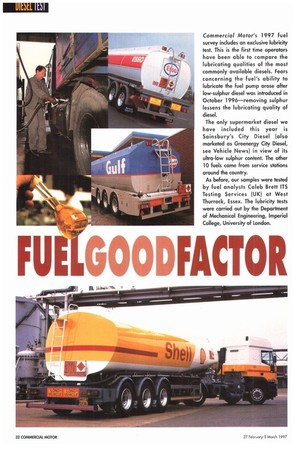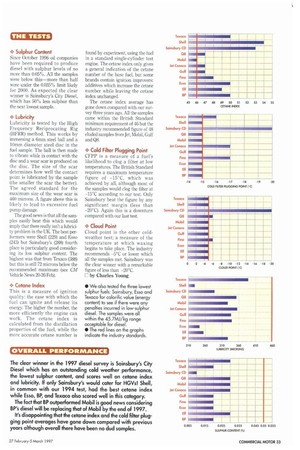GOODFACTOR
Page 34

Page 35

If you've noticed an error in this article please click here to report it so we can fix it.
+ Sulphur Content Since October 1996 oil companies have been required to produce diesel with sulphur levels of no more than 0.05%. All the samples were below this—more than half were under the 0.035% limit likely for 2000. As expected the clear winner is Sainsbury's City Diesel, which has 50% less sulphur than the next lowest sample.
Lubricity is tested by the High Frequency Reciprocating Rig (HFRR) method. This works by immersing a 6mm steel ball and a 10mm diameter steel disc in the fuel sample. The ball is then made to vibrate while in contact with the disc and a wear scar is produced on the disc. The size of the scar determines how well the contact point is lubricated by the sample (the smaller the scar the better). The agreed standard for the maximum size of the wear scar is 460 microns. A figure above this is likely to lead to excessive fuel pump damage.
The good news is that all the samples easily beat this which would imply that there really isn't a lubricity problem in the UK. The best performers were Shell (229) and Esso (243) but Sainsbury's (288) fourth place is particularly good considering its low sulphur content. The highest was that from Texaco (388) but this is still 72 microns below the recommended maximum (see CM Vehicle News 20-26 Feb).
This is a measure of ignition quality: the ease with which the fuel can ignite and release its energy The higher the number, the more efficiently the engine can work. The cetane index is calculated from the distillation properties of the fuel, while the more accurate cetane number is found by experiment, using the fuel in a standard single-cylinder test engine. The cetane index only gives a general indication of the cetane number of the base fuel, but some brands contain ignition improvers: additives which increase the cetane number while leaving the cetane index unchanged.
The cetane index average has gone down compared with our survey three years ago. All the samples came within the British Standard minimum requirement of 46 but the industry recommended figure of 48 eluded samples from Jet, Mobil, Gulf and Q8.
+ Cold Filter Plugging Point CFPP is a measure of a fuel's likelihood to clog a filter at low temperatures. The British Standard requires a maximum temperature figure of -15°C, which was achieved by all, although most of the samples would clog the filter at 15°C according to our test. Only Sainsbury beat the figure by any significant margin (less than 20°C). Again this is a downturn compared with our last test.
Cloud point is the other coldweather test; a measure of the temperature at which waxing begins to take place. The industry recommends -5°C or lower which all the samples met. Sainsbury was the clear winner with a remarkable figure of less than -20°C.
▪ by Charles Young












































































































